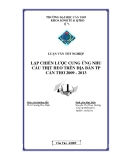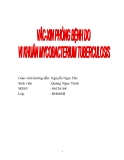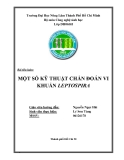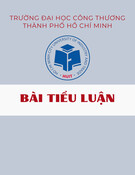
REVIEW Open Access
Zinc in innate and adaptive tumor immunity
Erica John
1
, Thomas C Laskow
1
, William J Buchser
1
, Bruce R Pitt
2
, Per H Basse
3
, Lisa H Butterfield
4
, Pawel Kalinski
1
,
Michael T Lotze
1*
Abstract
Zinc is important. It is the second most abundant trace metal with 2-4 grams in humans. It is an essential trace
element, critical for cell growth, development and differentiation, DNA synthesis, RNA transcription, cell division,
and cell activation. Zinc deficiency has adverse consequences during embryogenesis and early childhood develop-
ment, particularly on immune functioning. It is essential in members of all enzyme classes, including over 300 sig-
naling molecules and transcription factors. Free zinc in immune and tumor cells is regulated by 14 distinct zinc
importers (ZIP) and transporters (ZNT1-8). Zinc depletion induces cell death via apoptosis (or necrosis if apoptotic
pathways are blocked) while sufficient zinc levels allows maintenance of autophagy. Cancer cells have upregulated
zinc importers, and frequently increased zinc levels, which allow them to survive. Based on this novel synthesis,
approaches which locally regulate zinc levels to promote survival of immune cells and/or induce tumor apoptosis
are in order.
“Finding a potent role for zinc in the regulation of autop-
hagic PCD establishes zinc deprivation as a universal
cell death signal, regardless of which route of degrada-
tion–apoptotic or autophagic –is chosen by cells.”
Andreas Helmersson, Sara von Arnold, and Peter V.
Bozhkov. The Level of Free Intracellular Zinc Mediates
Programmed Cell Death/Cell Survival Decisions in Plant
Embryos. Plant Physiol. 2008 July; 147 (3): 1158-1167.
“It’s a business. If I could make more money down
in the zinc mines I’d be mining zinc.”Roger Maris
(American professional Baseball Player. 1934-1985)
“We have everything but the kits in zinc.”Albert
Donnenberg, PhD (Flow Cytometrist, UPSHS) 2009
Biological Role of Zinc
Zinc is the second most abundant metal in organisms
(second only to iron), with 2-4 grams distributed
throughout the human body. Most zinc is found in the
brain, muscle, bones, kidney, and liver, with the highest
concentrations in the prostate and parts of the eye. It is
the only metal that is a coenzyme to all enzyme classes
[1-3]. A biologically critical role for zinc was first
reported in 1869, when it was shown to be required for
the growth of the fungus, Aspergillus niger [4]. In 1926,
zinc was found to be required for the growth of plants
[5], and shortly thereafter, its first function in animals
was demonstrated [6-8]. Now, zinc has been shown to
be important also in prokaryotes [9]. In the last half-
century the consequences of zinc deficiency have been
recognized.
Zinc is a biologically essential trace element; critical
for cell growth, development and differentiation [10]. It
is required for DNA synthesis, RNA transcription, cell
division, and cell activation [11], and is an essential
structural component of many proteins, including sig-
naling enzymes and transcription factors. Zinc is
required for the activity of more than 300 enzymes,
interacting with zinc-binding domains such as zinc fin-
gers, RING fingers, and LIM domains [12-14]. The
RING finger domain is a zinc finger which contains a
Cys3HisCys4 amino acid motif, binding two zincs, con-
tains from 40 to 60 amino acids. RING is an acronym
specifying Really Interesting New Gene. LIM domains
are structural domains, composed of two zinc finger
domains, separated by a two-amino acid residue hydro-
phobic linker. They were named following their discov-
ery in the proteins Lin11, Isl-1 and Mec-3. LIM-domain
proteins play roles in cytoskeletal organization, organ
development and oncogenesis. More than 2000 tran-
scription factors have structural requirements for zinc to
bind DNA, thereby revealing a critical role for zinc in
gene expression.
* Correspondence: lotzemt@upmc.edu
1
Department of Surgery, University of Pittsburgh, 200 Lothrop Street,
Pittsburgh, PA 15213, USA
Full list of author information is available at the end of the article
John et al.Journal of Translational Medicine 2010, 8:118
http://www.translational-medicine.com/content/8/1/118
© 2010 John et al; licensee BioMed Central Ltd. This is an Open Access article distributed under the terms of the Creative Commons
Attribution License (<url>http://creativecommons.org/licenses/by/2.0</url>), which permits unrestricted use, distribution, and
reproduction in any medium, provided the original work is properly cited.

Zinc is required for both normal cell survival (as above)
and for cell death via its role in apoptosis. We propose
that zinc may also regulate autophagy and other forms of
survival due to its early sensitivity to cell stress. Thus,
zinc could play a central role, regulating apoptosis and
autophagy as well as immune cell function. Cancer cells
are continuously stressed (genomic stress, ER stress,
nutrient stress, oxidant stress, etc) and selected for survi-
val (likely by autophagy). Here we review the current stu-
dies surrounding zinc, and propose that zinc has a
spectrum of effects on cell death and survival, where zinc
depletion induces cell death via apoptosis (or necrosis if
apoptotic pathways are blocked) while sufficient zinc
levels allows maintenance of cell survival pathways such
as autophagy and regulation of reactive oxygen species.
Cancer cells have upregulated zinc importers, and most
frequently increased zinc levels, which allow them to sur-
vive. Based on these notions, means to locally regulate
zinc levels to promote survival of immune cells and pro-
mote tumor apoptosis are in order.
Dietary Zinc and Deficiency
Red meat is the primary sources of zinc for most Amer-
icans. The already low amount of zinc in vegetables is
further chelated by phytates and is therefore not as
available for absorption. Nuts, and fruits, whole grain
bread, dairy products, and fortified breakfast cereals are
other sources of zinc. Oysters have the highest zinc per
serving of any common food [15,16].
Zinc is taken up primarily in the proximal small intes-
tine, and depends heavily on ZIP4. Once transported
through the enterocytes and into the blood, zinc binds
to albumin, transferrin, a-2 macroglobulin, and immu-
noglobulin G, and travels to the liver where the zinc is
stored in hepatocytes until it is released back into the
blood to again bind carrier molecules and travel to the
tissues where zinc intake will be regulated by zinc
import and transport proteins [17].
Over one billion people in developing countries are
nutritionally deficient in zinc [18]. Zinc deficiency is
associated with a range of pathological states, including
skin changes, loss of hair, slowed growth, delayed
wound healing, hypogonadism, impaired immunity, and
brain development disorders [6,10,19], all of which are
reversible with zinc supplementation. Zinc deficiencies
occur as a result of malabsorption syndromes and other
gastrointestinal disorders, chronic liver and renal dis-
eases, sickle cell disease, excessive alcohol intake, malig-
nancy, cystic fibrosis, pancreatic insufficiency,
rheumatoid arthritis, and other chronic conditions
[18,20-25]. In humans, acrodermatitis enteropathica-like
eruptions are commonly found with zinc deficiency [26].
These pathological states and the associated zinc defi-
ciencies are linked to increased infection and prolonged
healing time, both of which are indicators of compro-
mised immunity. In developing countries, previously
pervasive conditions such as diarrhea [27] and lower
respiratory illness [28] are associated with low zinc.
Unfortunately, quantifying human zinc to identify defi-
ciency and preventing zinc toxicity (due to excess sup-
plementation) is an ongoing challenge [29]. These
findings suggest a role for zinc in immune cell homeos-
tasis in vivo [30,31].
A Signaling Ion
Zinc may act as a signaling molecule, both extracellularly
(as in neurotransmitters) and intracellularly (as in cal-
cium second-messenger systems). In nerve cells, zinc can
be found in membrane-enclosed synaptic vesicles, from
which it is released via exocytosis to bind ligand gated
ion channels (such as NMDA receptors, Ca2+-permeable
AMPA/kainite receptors, and voltage-dependent Ca2+
channels (VDCC)), activating postsynaptic cells [32].
Additionally, changes in the concentration of intracellular
free zinc control immune cell signal transduction by reg-
ulating the activity of major signaling molecules, includ-
ing kinases (PKC, LCK), phosphatases (cyclic nucleotide
phosphodiesterases and MAPK phosphatases), and tran-
scription factors (NFkB).
In T cells, zinc treatment stimulates the kinase activity
of PKC, its affinity to phorbol esters, and its binding to
the plasma membrane and cytoskeleton [33], while zinc
chelators inhibit the induction of these events [34]. Zinc
ions also promote activation of LCK, a Src-family tyro-
sine kinase, and its recruitment to the T cell receptor
complex [35]. The interaction of LCK with CD44 is also
zinc dependent [36]. The release of zinc from lysosomes
also appears to promote T-cell proliferation in response
to IL-2R activation. Here, zinc causes its effect through
the ERK pathway, possibly by inhibiting the depho-
sphorylation of MEK and ERK [37]. Additionally, zinc
regulates inflammatory signaling in monocytes treated
with lipopolysaccharide (LPS), interacting with cyclic
nucleotide phosphodiesterases and MAPK phosphatases
[38-40]. NFkB is a transcription factor involved in cellu-
lar responses to stressful stimuli including cytokines,
free radicals, ultraviolet irradiation, oxidized LDL, and
bacterial or viral infection that plays a key role in regu-
lating the immune response [41]. Zinc regulates
upstream signaling pathways leading to the activation of
this transcription factor [38], as well as potentially regu-
lating NFkB itself [42]. Interestingly, peripheral blood
mononuclear cells (PBMC) from zinc-deficient elderly
individuals show impaired NFkB activation and dimin-
ished interleukin (IL-2) production in response to sti-
mulation with the mitogen phytohemagglutinin (PHA),
corrected by in vivo and in vitro supplementation of
zinc [43].
John et al.Journal of Translational Medicine 2010, 8:118
http://www.translational-medicine.com/content/8/1/118
Page 2 of 16

In studies measuring changes in intracellular ions such
as calcium and magnesium, the tools used are partially
sensitive to zinc as well. Accurate measurement of intra-
cellular zinc requires indicators with high zinc selectiv-
ity. Currently, the single wavelength dye FluoZin-3
(Invitrogen) responds to small zinc loads, is insensitive
to high calcium and magnesium ions, and is relatively
unaffected by low pH or oxidants [44]. It is noteworthy
that FluoZin-3 fluorescence is non-ratiometric and thus
precludes a precise quantitative determination of labile
zinc, a long sought after goal. Measuring “free zinc”is
complicated by the relative abundance of unoccupied
high-affinity binding sites in most cells. Correctly ascer-
taining free zinc would depend on several factors,
including the buffering capacity and the dissociation
constant of the zinc chelating agent [45,46].
Zinc and the Immune Response
Zinc deficiency affects multiple aspects of innate and
adaptive immunity, the consequences of which in
humans include thymic atrophy, altered thymic hor-
mones, lymphopenia, and compromised cellular-and
antibody-mediated responses that result in increased
rates and duration of infection. Zinc deficiency also
plays a role in the immunosenescence of the elderly
[47]. Changes in gene expression for cytokines, DNA
repair enzymes, zinc transporters, and signaling mole-
cules during zinc deficiency suggest that cells of the
immune system are adapting to the stress of suboptimal
zinc [48]. Furthermore, oral zinc supplementation
improves immunity and efficiently down-regulates
chronic inflammatory responses [34]. These general
findings suggest that zinc is critical for normal immune
cell function, whereby zinc depletion causes immune
cell dysfunction, and zinc supplementation can either
restore function in the setting of dysfunction or improve
normal immune cell function [49].
Zinc and Adaptive Immunity
The adaptive immune response is based on two groups
of lymphocytes, B cells that differentiate into immuno-
globulin secreting plasma cells and thereby induce
humoral immunity, and T cells that mediate cytotoxic
effects and helper cell functions of cell mediated immu-
nity [34]. The known interactions of zinc and the
immune system are categorized in Table 1 and Table 2.
Both responses depend on the clonal expansion of cells
following recognition of their cognate antigen.
Zinc deficiency adversely affects lymphocyte prolifera-
tion. Zinc deficient conditions are associated with ele-
vated glucocorticoids, which cause thymic atrophy and
accelerate apoptosis in thymocytes, thereby reducing
lymphopoiesis [50,51]. In murine studies, zinc-deficient
diets cause substantial reductions in the number of CD4
+ and CD8+ thymocytes with the observation. Naïve
cells sustain high levels of apoptosis in response to zinc-
deficiency-induced elevated levels of glucocorticoids.
Mature CD4+ and CD8+ T cells are resistant to zinc
deficiency and can survive thymic atrophy, possibly
because of higher levels of the anti-apoptotic protein
BCL2 [48,52]. Interestingly, myelopoiesis is preserved in
zinc deficiency, thereby sustaining some aspects of
innate immunity.
Arguably the most prominent effect of zinc deficiency
is a decline in T cell function that results from multiple
causes. First, thymulin, a hormone secreted by thymic
epithelial cells that is essential for the differentiation
and function of T cells, requires zinc as a cofactor and
exists in the plasma in a zinc-bound active form, and a
zinc-free, inactive form [34]. In mice with normal thy-
mic function, zinc deprivation reduces the level of biolo-
gically active thymulin in the circulation [53], thereby
reducing the number of circulating T cells. Zinc supple-
mentation reverses this effect [54,55].
Second, zinc deficiency leads to altered gene expres-
sion in T cells resulting in an imbalance between the
peripheralfunctionsoftheTh1andTh2cellpopula-
tions [10]. Zinc deficiency decreases production of the
Th1 cell cytokines, IFN-g, IL-2, and tumor necrosis
factor (TNF)-a, which play major roles in tumor sup-
pression. These in turn inhibit the functional capacity
of these cells. Production of the Th2 cytokines IL-4,
IL-6, and IL-10 are not affected. Regeneration of CD4+
T lymphocytes and CD8+ CD73+ CD11b-, precursors
of cytolytic T cells, are decreased in zinc-deficient sub-
jects with impaired immune function. An imbalance
between Th1 and Th2 cells, decreased recruitment of
T naive cells, and decreased percentage of T cytolytic
cells are likely responsible for the cell-mediated
immune dysfunction observed in zinc-deficient subjects
[56,57].
Third, in mice, modest zinc deficiencies alter levels of
specific thymic mRNA and proteins even before altera-
tions occur in thymocyte development. Specifically, zinc
deficiency depresses expression of myeloid cell leukemia
sequence-1 (MCL1), the longer product enhancing cell
survival while the alternatively spliced (shorter) form
promoting apoptosis. It also enhances expression of the
DNA damage repair and recombination protein 23B
(RAD23B), and the mouse laminin receptor (LAMR1)
and the lymphocyte-specific protein tyrosine kinase
(LCK) [58], perhaps as secondary effects. Conversely,
zinc supplementation suppresses the development of
Th17 cells in both mouse models and cultured human
and mouse leukocyte cell lines. In vivo and in vitro, zinc
inhibits IL-6 induced phosphorylation of STAT3, and
this observation could in part explain how zinc impedes
the formation of a Th17 response [59].
John et al.Journal of Translational Medicine 2010, 8:118
http://www.translational-medicine.com/content/8/1/118
Page 3 of 16

Role in Innate Immunity
Natural killer (NK) cells, dendritic cells (DCs), macro-
phages, mast cells, granulocytes, and complement com-
ponents represent central elements of innate immunity.
As observed in adaptive immune cell function, zinc defi-
ciency results in immune dysfunction in innate immu-
nity as well. Specifically, zinc deficiency reduces the lytic
activity of natural killer cells, impairs NKT cell cytotoxi-
city and immune signaling, impacts the neuroendocrine-
immune pathway, and alters cytokine production in
mast cells [60-62]. Zinc supplementation enhances
innate immunity against enterotoxigenic E.coli infection
in children due to increases in C3 complement,
enhanced phagocytosis, and T cell functionality [63].
NK cells
Zinc deficiency reduces NK cell lytic activity in zinc
deficient patients, while zinc supplementation improves
NK cell functions. For example, zinc treatment at phy-
siological doses for one month in elderly infected
patients, increases NK cell cytotoxicity and enhances
recovery of IFN-gproduction leading to a 50% reduction
in relapse of infection [61]. Additionally, in vitro,zinc
supplementation improves the development of NK cells
from CD34+ cell progenitors via increased expression of
GATA-3 transcription factor [60]. Notably, centenarians
have well-preserved NK cell cytotoxicity, zinc ion bioa-
vailability, satisfactory IFNgproduction, and preserved
thyroid hormone turnover [62], suggesting the impor-
tance of zinc in maintaining both NK cell function and
the immunologically involved neuroendocrine pathway
in the elderly. Its role in regulating Class I MHC mole-
cules has not been extensively studied, but it does
appear that it is critical for HLA-C interaction with
killer cell Ig-like receptors (KIRs). Interestingly, the
kinetics of the binding of KIR to their respective indivi-
dual Class I MHC ligands is altered significantly in the
presence of zinc, but not other divalent cations. Zinc-
induced multimerization of the KIR molecules may be
critical for formation of KIR and HLA-C molecules at
the interface between the NK cell and target cells [30].
Metallothioneins (MTs), small cysteine-rich proteins
that bind zinc as well as other metal ions, mediate zinc
homeostasis, and are therefore critical to not only NK
function but also other cellular functions. Recent studies
in aging show a novel polymorphism in the MT1A cod-
ing region in MT genes that affects NO-induced zinc
ion release from the protein [64]. Other polymorphisms
in MT genes impair innate immunity, further confirm-
ing a link among zinc, MT, and the innate immune
response during aging.
NKT Cells
NKT cells are a bridge between the innate and the
adaptive immune systems [65], displaying both cytotoxic
abilities as well as providing signals required for driving
the adaptive immune response. Both zinc and MTs
affect NKT cell development, maturation, and function.
In conditions of chronic stress including aging, zinc
release by MTs is limited, leading to low intracellular
zinc bioavailability and subsequent reduced immunity
[31]. Furthermore, during stress and inflammation,
expression of MTs is induced by the pro-inflammatory
cytokines IL-1, IL-6, and tumor necrosis factor (TNF)-a
[66], resulting in further sequestration of zinc by MTs
[67].
Additionally, some zinc finger motifs play an impor-
tant role in the immune response of NKT cells. The
BTB-ZF transcriptional regulator, promyelocytic leuke-
miazincfinger(PLZF),isspecificallyexpressedin
Table 1 Zinc and Immune Cell Functions
Cell Type Comment References
Macrophages MT-knockout results in defects in phagocytosis and antigen presentation [73]
Dendritic cells Zinc induces maturation and increases surface MHCII [70]
NK cells Zinc increases cytotoxicity and restores IFN-gproduction [50,52,61]
NKT cells Zinc release from MTs in limited during chronic stress. Stress and inflammation induce MT gene expression, further
sequestering zinc
[31,66,67]
iNKT cells Cells lacking PLZF lack innate cytotoxicity and do not secrete IL-4 and IFN-g[68]
CD4
thymocytes
Zinc deficiency elevates glucocorticoid levels, causing apoptosis and reduced numbers of thymocytes [52,57]
CD4 helper
T cells
Zinc deficiency shifts Th1 to Th2 response via altered cytokine release [10,48,56,176]
CD8
thymocytes
Zinc deficiency results in reduced numbers of thymocytes due glucocorticoid-induced apoptosis [48,52]
T cells Zinc deficiency results in decreased function due reduced biologically active thymulin [53-55]
T reg ?
Mast cells Required for IL-6 and TNF-aproduction [71,72]
John et al.Journal of Translational Medicine 2010, 8:118
http://www.translational-medicine.com/content/8/1/118
Page 4 of 16

invariant natural killer T (iNKT) cells (Table 2). In the
absence of PLZF, iNKT cells have markedly diminished
innate cytotoxicity and do not secrete IL-4 or IFN-gfol-
lowing activation [68]. Thus, zinc deficiency causes a
reduction in both innate and adaptive immune function-
ing in NKT cells.
Hormonal Influence
Hormones from the hypothalamic-pituitary-gonadal axis
(i.e. FSH, ACTH, TSH, GH, T3, T4, insulin, and the sex
hormones) directly affect the innate immune response,
interacting with hormone receptors on immune cells,
including NK cells. Hormonally activated NK cells pro-
duce cytokines that mediate adaptive immune responses.
Deficient production of these hormones impairs innate
and adaptive immune response in aging. The beneficial
effects of hormone supplementation on immunity are
mediated in part by enhanced intestinal zinc absorption.
Therefore, zinc is a nutritional factor pivotal in main-
taining the neuroendocrine-immune axis [69].
Dendritic cells (DCs)
DCs are also profoundly affected by zinc. Exposure of
mouse dendritic cells to LPS, a toll-like receptor 4
(TLR4) ligand, leads to a decrease in the intracellular
free zinc concentration and a subsequent increase in
surface expression of MHC Class II (Figure 1), thereby
enhancing DC stimulation of CD4 T cells [70].
Table 2 Zinc and Proteins of Immunological Significance
Protein Immunological Role References
Calcineurin Zinc inhibits Calcineurin activity in Jurkat cells [177]
COX-2 Lung zinc exposure increases COX-2 [178]
Caspases Cytosolic caspase-3 activity is increased in Zn-deficient cells. May be mediated by the cytoprotectant abilities of zinc [110]
E-selectin Zinc deficiency increased E-selectin gene expression [179]
FC epsilon
RI
Mast cell activation downstream of FC epsilon requires zinc [72,180]
HMGB1 3 Cys, 2 His, unknown role of zinc [174]
HSP70 Zinc increased basal/stress-induced Hsp70 in CD3+ lymphocytes [181]
IFN-gZIP8 influences INF-gamma in T cells [177]
IL-1 bZinc suppresses IL-1 beta expression in monocytes [39,182]
IL-2 High zinc decreased IL-2 in T cell line, Jurkat cells [183,184]
IL-2R aHigh zinc decreased IL-2R ain T Cell Line [184]
IL-6 Zinc modulated circulating cytokine in elderly patients [61,185,186]
KIR Zinc is necessary for the inhibitory function of KIRs [187,188]
MCP-1 Zinc modulated circulating MCP-1 in elderly patients [185]
MHC Class
II
There is zinc dependent binding site where super-antigens and peptides bind [189,190]
NFkB NFkB p65 DNA-binding activity increased by zinc deficiency (sepsis). Zinc regulates NFkB. High zinc decreases NFkB
activation in T Cell Line. Zinc activates NFkB in T cell line. IKK gamma zinc finger, can regulate NFkB
[42,179,191,192]
PDE-1,3,4 Zinc reversibly inhibited enzyme activity of phosphodiesterases. [39]
PPAR-aZinc deficiency down-regulated PPAR-a[184]
Proteasome Zinc can inhibit proteasome [193]
S100
Proteins
RAGE ligands [173]
TLR-2 Zinc limits TLR surface expression [194]
TNF-aZinc suppresses TNF-aexpression in T-Cells, monocytes [39,40,184]
Zinc finger proteins
A20 zinc
finger
Modulates TLR-4 signaling, Inhibits TNF-induced apoptosis [192,195]
DPZF BCL-6 Like Zinc Finger, Immune responses [196]
Gfi1 Antagonizes NFkB p65, Upstream of TNF [197,198]
IKK gZinc finger that regulates NFkB [199]
PLZF Expressed in iNKT cells. iNKT cells lacking PLZF lack innate cytotoxicity and do not secrete IL-4 or IFN-g[68]
ZAS3 Zinc Finger protein that inhibits NFkB [200]
John et al.Journal of Translational Medicine 2010, 8:118
http://www.translational-medicine.com/content/8/1/118
Page 5 of 16












![Bệnh Leptospirosis: Khóa luận tốt nghiệp [Nghiên cứu mới nhất]](https://cdn.tailieu.vn/images/document/thumbnail/2025/20250827/fansubet/135x160/63991756280412.jpg)











